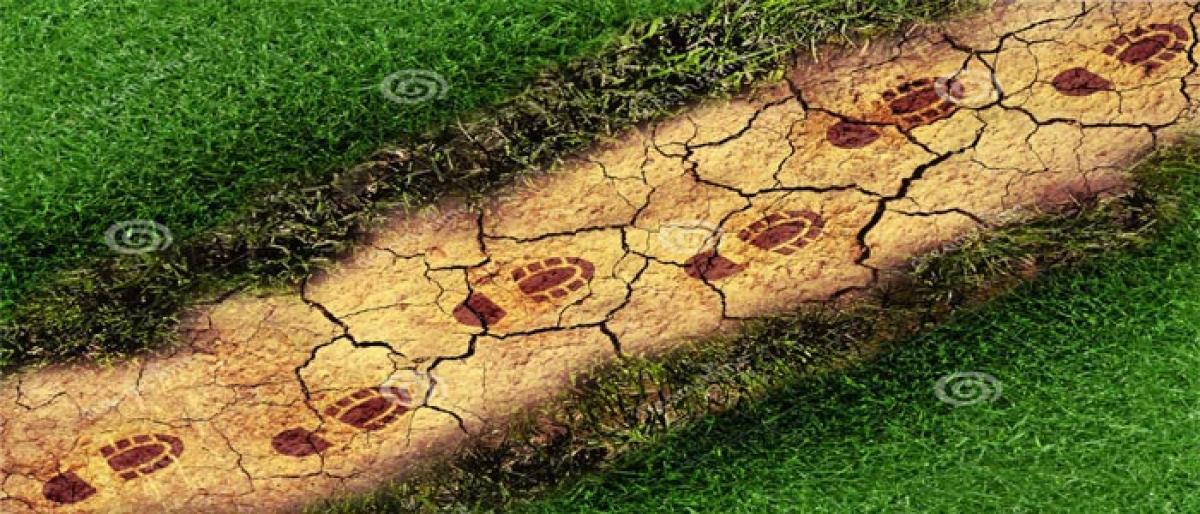Human impact on ecology and environment

Like any life form, man also has to depend on the natural resources for his survival. Air, water, land, atmosphere, living organisms - each of these elements is useful in some form or other to human beings.
Like any life form, man also has to depend on the natural resources for his survival. Air, water, land, atmosphere, living organisms - each of these elements is useful in some form or other to human beings. However in the last 200 years or so, technological advancement has made human beings rapacious in their exploitation of natural resources. This has led to the degradation of environment physically, chemically, biologically and ethically. Though, there has been considerable awareness at various levels about conservation of resources, there seems to be no perceptible holistic, approach to achieve the twin objectives, viz., preservation along with utilisation. The problem arises due to two reasons: The continuous human intervention in the dynamic natural evolutionary processes, the steady state environment is not attainable and the perfect compatibility is also in conflict with man's continuous effort to innovate and improve the state of affairs in his own interest.
The rapid increase in human population over the centuries and an amazing development of Science and Technology as an integral part of the culture have had the most profound impact on the ecosystem. No other organism has produced such an impact on the physical, chemical, and biological constitution of the earth. Humans have become capable of altering their physical environment to suit themselves, creating major long term problems which have been catastrophic both for natural environment and for humans themselves.
Environmental degradation refers to the deterioration in the physical component of environment, mainly due to biological processes, but more specifically due to human activity, to such a great extent that it cannot be easily restored by the self regulatory mechanism or homeostatic mechanism of the environment. Environmental degradation may be due to Extreme events or hazards or due to pollution. Extreme events can be classified on the basis of causative factors. Natural hazards are caused by natural factors example volcanic eruptions, earthquakes etc are caused by endogenetic forces. Atmospheric natural hazards occur due to atmospheric processes example cyclones, forest fires, floods etc. Human induced hazards are the result of cumulative and even sudden effects of man's activities.
These could be physical man induced hazards, caused by large-scale landslides, deliberate forest fires etc., chemical and nuclear hazards caused by the release of toxic elements in the atmosphere by human activities, accidental outbursts of poisonous gases from some chemical factories, nuclear explosions and biological hazards induced by man for example sudden increase or decrease in the population of a species in a region due to Increase in nutrients or increase in toxic elements. Biological hazards include dangers posed by epidemics, natural extinction of any particular species, locust Swarms etc.
Important causes that have led to the degradation of ecosystem are deforestation, overgrazing, agriculture, mining and urbanisation.
Deforestation
Deforestation means wanton cutting of trees including repeated lopping, felling, removal of forest litter, browsing, grazing and trampling of seedlings. It results mainly from
1) shifting cultivation
2) development projects
3) demand for fuel wood
4) demand for wood for industry
and for commercial purposes
5) other causes.
1) Shifting cultivation
This method of cultivation is practised all over the world but is more prevalent in the tropical countries. In this practice a patch of land is cleared, vegetation is burned and the ash is mixed with the soil thus adding nutrients to the soil. This patch of land is used for raising crops for 2 to 3 years, and this yield is modest. In India it is widely practiced in North Eastern region comprising the states of Assam, Meghalaya, Nagaland, Manipur, Tripura, Arunachal Pradesh and Mizoram and in Andaman NIcobar islands. This is locally known as jhum in North Eastern region, podu in Andhra Pradesh, Bewar or dahza in Madhya Pradesh, in Orissa it is known as the dahi, gudiya and chas.
2) Development projects
The use of science and technology to support the ever increasing needs of man is termed as development. Any country, especially the developing countries like ours would have to undergo the process of development at a much rapid rate to fulfill the requirements of its people. Likewise, in the recent years we have witnessed a number of developmental projects completed and several others coming up.
Development projects like the hydroelectric projects, large dams and reservoirs, laying down Railway lines and roads are not only extremely beneficial, but they are also linked with several environmental problems. Many of these projects require immense deforestation. Deforestation effects not only the biota and neighbouring ecosystems, but the soil is eroded, land is degraded, groundwater channels are altered, and water becomes polluted and scarce.
3) Demand for fuel wood
The increasing demand for fuel wood is one of the major factors leading to the degradation of forest ecosystem. Fuel wood is of such major importance as a forest produce that about one-half of all the wood cut in the world is used for lighting, cooking or heating purposes. Increasing demand for firewood with every passing year means greater pressures on the forests, which also means increased intensity of deforestation.
4) Raw materials
wood is not only used as fuel, but it also has a variety of other purposes. It is used in making boxes, crates, packing cases, paper etc. Since large number of industries are dependent on forests thoughtless and unrestricted exploitation of forest for raw materials is the main cause of degradation of the forest ecosystem.
5) Other causes
Natural enemies like termites, pests and several kinds of diseases affect the forests adversely. There is also a massive destruction of forests because of floods and fires.
Changeses caused due to Overgrazing and Agriculture: Overgrazing refers to the condition when the grazing pressure on the vegetation is so intense that it does not recover leading to a loss of soil binding cover (deforestation) which results in soil erosion and desertification. Deforestation and overgrazing combined makes desertification intense. As well vegetation retrogresses, with continued overgrazing, the crucial soil and water relationships fail, ultimately reducing the area's carrying capacity of the animals. Rate of water infiltration is proportionally related to grazing intensity. Water infiltration is low in heavily grazed areas and high in lightly grazed areas. Heavily grazed areas also have high rates of runoff.
Changes in environment caused by man through his Agrop-pastoral activities can be divided into two types:
a) changes brought about by traditional agriculture and
b) changes brought about by modern agriculture. The characteristics of traditional agriculture include defacement of land, deforestation coupled with loss of soil structure, soil erosion and depletion of soil nutrients. Some of these changes are also shared by overgrazing. Overgrazing, in fact is also a byproduct of efforts to exploit the land resources for maximum livestock production regardless of ability of the ecosystem to with stand external interventions. The second type of changes are those brought about by modern agriculture. Modern agriculture and traditional agriculture share the same disruptive effects. There are certain disruptive effects which are characteristic only of modern agricultural practices. For example excessive irrigation, twin problems of salinization and water logging resulting from rise in water table apart from causing depletion of groundwater resources. Another example is the addition of chemical fertilizers which increase depletion of micro nutrients from soils, eutrophication of water bodies etc. Likewise use of high yielding varieties makes agriculture market oriented, encourages monoculture causing eruption of epidemics and depletion of genetic diversity.
Degradation of the ecosystem due to agriculture can be on the following accounts
1) Removal of trees (deforestation) and clearing the land for agriculture destroys the habitats of many kinds of living organisms. Deforestation ultimately leads to the problems like soil erosion, loss of nutrients and desertification.
2) Cultivating the land intensely without proper soil management, leads to problems like soil erosion, desertification and depletion of plant nutrients.
3) Irrigation without sufficient drainage leads to excessive accumulation of water (water logging) or salts (salinization), rise in water table in the soil, ultimately leading to the degradation of quality of soil.
4) Indiscriminate use of agrochemicals - fertilizers and pesticides, leads to their increased build up, often reaching harmful levels in the soil and the underground water resources. This causes the bioaccumulation in the food chain. These Chemicals also degrade the quality of soil and ultimately the ecosystem.
Mining Mining may be defined as the removal of minerals and other materials from Earth's crust for the welfare and prosperity of man. Modern industrial, economic and commercial activity depends a lot on the exploitation and consumption of minerals. The process of Extraction of mineral resources and its use in various ways generates a wide range of environmental changes - often leading to degradation of ecosystem and far reaching consequences. The recovery of minerals and construction material require to remove the vegetative cover on land with underlying soil mantle and excavating overlying rock masses (known as overburden). The amount of overburden commonly exceeds the generation of great volume of materials are minerals sought.
The result is reshaping of the topography, generation of great volumes of debris and disruption of surface and ground water circulations. These further lead to soil erosion, increased incidences of landslides and ultimately Land Degradation.
Mining activities not only affect Terrestrial ecosystem but also affect ocean ecosystems. Mining activity in oceans have immense potential and has increased considerably in the last few years. It is also causing concern because of its effect on the area and ultimately the life. Ocean floor mining on extensive scale to recover polymetallic nodules will have considerable effect on the benthic biotic community, giving rise to the stirring up of sediments and formation of flumes of suspended materials. The sediments and the wastes remaining after processing the nodules, if allowed to be washed down back to the sea, would affect the life on the shallow sunlight coastal belts. Particularly the spawning of fishes and other fauna will be seriously affected.
Urbanisation:- For more than 200 years, the world's population has tended to concentrate in a relatively small part of the Earth's surface in towns and cities. This settlement of people in small areas is called urbanization.
Environmental degradation caused due to urbanization
1) Encroachment of fertile agricultural or forest land for housing, industries, construction of roads and dams leading to deforestation. Thus the biological diversity of that area is lost for ever.
2) For construction purposes large quantities of building materials are required. Kilns, where bricks are made pollute the atmosphere and use a huge amount of nutrient rich soil for brick making. Thus fertile land which would have been good for agriculture is degraded and is lost.
3) Development of industry goes hand in hand with urbanization. Some industries due to their by products/ emissions and excessive utilisation of natural resources, affect the ecosystem considerably.
4) Slums represent the worst type of environmental degradation. Development and proliferation of slums is concomitant with urbanisation and industrialisation. The slum dwellers have an environment with inadequate living space, water supply, sewerage facilities etc. This causes deterioration of surrounding regions as well as human health.
Modification of river processes
Human induced modifications of river processes have adverse affects on environment. Modifications include construction of dams and reservoirs, channelisation of streams, canal diversion and interlinking of rivers.
Modification of atmosphere
The global heat balance has been disturbed over the last few decades due to human activities. The following are the atmospheric changes induced by human activities:
i) Introduction of solids and gases not
normally found in the atmosphere.
(pollutants)
ii) Changes in the proportions of natural
component of gases in the atmosphere.
iii) Alterations in earth's surface in such a
way to affect the atmosphere.
Introduction of alien species
Introduction of alien species either by man or by nature leads to their fast growth, outnumbering many existing species altering ecosystem. This problem acquired a new dimension with rapid advances in biotechnology and laboratory breeding of plants and animals with the desired characteristics.
Previously asked questions
1) In India, the problem of soil erosion is associated with which of the following?
1) Terrace cultivation
2) Deforestation
3) Tropical climate
Select the correct answer using the code given below
a) 1 and 2 only
b) 2 only
c) 1 and 3 only
d) 1, 2 and 3
Solution (b)
2) Salinization occurs when the irrigation
water accumulated in the soil evaporates, leaving behind salts and minerals. What are the effects of salinization on the
irrigated land?
a) It greatly increases the crop production.
b) It makes some soils impereable.
c) It raises the water table.
d) It fills the air spaces in the soil with water.
Solution (b)
3) Which of the following type of farming is known as "Jhumming" ?
a) Shifting farming
b) Subsitence farming
c) Terrace farming
d) Irrigated farming
Solution (a)
















